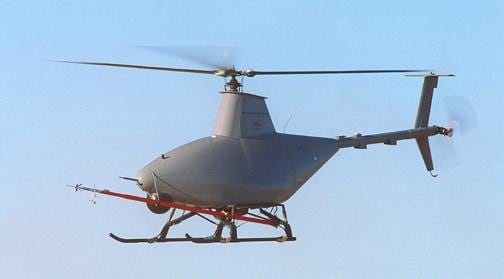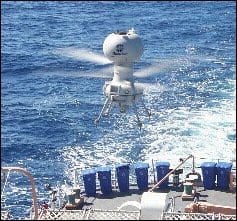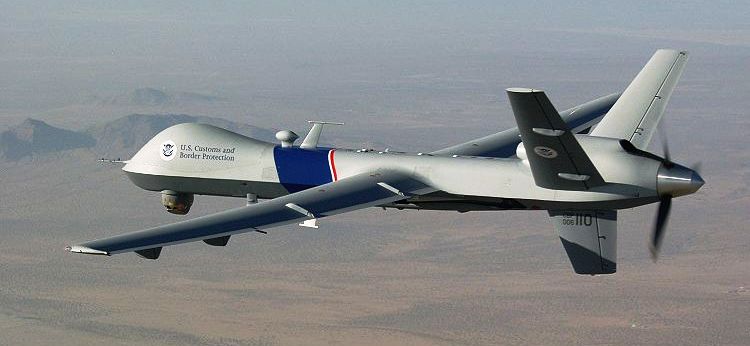CL-327 Operating From USCGC Thetis
Today’s Unmanned Aerial Vehicles (UAVs) owe much to the design of the cruise missiles that were used in World War II by the US and British forces. At the close of World War II, Chance Vought Aircraft, a company with no missile experience, was contracted to further develop the concept. What won Vought the contact was that the proposed test missile would have landing gear, which would help save cost. This was the beginning of the modern UAV/UAS.
A UAS is an aircraft that flies without a crewmember on board the aircraft. To distinguish UASs from missiles, a UAS is defined as a reusable vehicle capable of controlled, sustained, level flight controlled from a Ground Control Station (GCS) and powered by a jet or reciprocating engine. There are a wide variety of UAS shapes, sizes, configurations, and characteristics.
Note: The industry standard terminology “Unmanned Aerial Vehicle UAV” was changed to “Unmanned Aircraft System (UAS)” due to considerations with respect to operations in the National Airspace System. UAV –UAS both describe the same capability. The acronym UAS will be used in the remainder of this narrative.
Upgraded fixed-wing search and shipboard- helicopter operations in the Coast Guard proved to be highly successful as force multipliers. This coupled with the notable development of UASs for surveillance purposes at reduced operational costs led the United States Coast Guard Research and Development Center (R&DC) to conduct multiple analyses during the past several years to explore the potential benefits of integrating UAS technology into Coast Guard operations.
Several of the evaluations conducted in this phase of development were :
- The first UAS to launch and recover from a Coast Guard vessel took place aboard the USCG Cutter Thetis during the period 21-22 November 1999. The UAS was a Bombardier CL a small vertical lift machine utilizing a set of coaxial rotor emanating from the waist of the system.
- In February/March 2001, the R&DC deployed the Condor Small UAS from the USCG Cutter Harriet Lane. The intent of this deployment was to learn about operating a UAS from a cutter, evaluate the usefulness of the information provided by a UAS and identify system and performance requirements for future UAS acquisitions.
- In August 2002, the R&DC completed a four-day, shore-based field test in Galveston, TX utilizing the Sentry HP small UAS.
- In 2003, deployment and evaluation of a General Atomics Predator model “A” was performed from King Salmon, Alaska. The Predator “A” is a Medium Altitude Long Range (MALE) UAS with significantly more capabilities for range, payload, and endurance than a small UAS. The objective of this test was to evaluate the potential for UAS in the Alaskan airspace using simple line of sight (LOS) flight controls.
Following the successful completion of the Predator “A” evaluation, a more comprehensive evaluation was planned using a modified General Atomics Predator “B” model. This evaluation was intended to fly the MALE UAS over-the-horizon (OTH) by handing off control to a ground control station in Juneau, Alaska, and operating the UAS via satellite communications. The evaluation was also intended to include operational analysis of an onboard sensor suite to detect, classify, and identify targets of interest operating within the operation area (OPAREA), including the 100-fathom curve, Maritime Boundary Line (MBL) and high seas drift net area.
During 1999 Executive Order 13115 was issued by the President creating and directing a Task Force to “provide advice and recommendations regarding the appropriate roles and missions for the United States Coast Guard through the year 2020.” While the Executive Order sought a review of all Coast Guard roles and missions, it directed the Task Force to give special attention to the deepwater missions of the Coast Guard. The President emphasized deepwater missions because the Coast Guard was currently pursuing its Deepwater Capabilities Replacement Project which involves the replacement or modernization of many of the ships and aircraft used in search and rescue, drug interdiction, the interception of illegal immigrants, fisheries regulation, defense operations, and other at-sea operations. Initial contracts on the Deepwater Project were awarded in 2002 and in 2003 the Coast Guard Aviation Plan was initiated.
The Coast Guard Aviation Plan included the upgrade of certain legacy aircraft; the procurement of specific new aircraft and the inclusion of specific UAS aircraft into future Coast Guard aviation assets. The Deepwater Program developed management and cost problems with surface assets and was harshly criticized. The aviation plan fared much better. The initial UAS choices were the leasing of four modified RQ-4 Global Hawk UASs. The Global Hawk was selected to fulfill the requirement for a high-altitude, long-endurance land-based UAS. Leasing was anticipated to begin in 2014. This did not take place due to mission cost-effectiveness considerations. To fill the shipboard requirements; Bell Helicopter was awarded a contract to commence concept and preliminary design work on the HV-911 Eagle Eye vertical take-off and landing unmanned aerial vehicle. Prototypes were developed and built for testing in 2005. This was later extended to 2007 because of revisions in the Deepwater Program. The initial plan included the purchase of 69 Eagle Eyes to operate from the new National Security Cutters (NSC) and Offshore Patrol Cutters (OPC). The total number of HV-911s was later reduced to 45 air vehicles. During early flight testing, a catastrophic loss of the air vehicle was experienced. As a result of the accident the Coast Guard put the HV-911 project on hold and began an extensive review. Due to the potential for further technical difficulties and large development costs the project was terminated in June 2007.
Upon cancellation of the contract, the UAS acquisition plan was re-evaluated and the Coast Guard began working with a number of government agencies and industry to analyze both cutter-based and land-based UAS alternatives. Available for consideration were four broad types of UASs: hand launched such as the RQ-4 Dragon Eye; medium-altitude, tactical UASs such as the Navy shipboard RQ-8 Fire Scout; and the medium-altitude long-range UASs RQ-1-, MQ-9B Predator;
The MQ-9B Predator was a proven UAS. It is an upgraded model of the initial Predator-A with approximately three times more payload. In 2001 the original power plant was replaced by a turboprop engine. The U.S. Customs and Border Patrol (CBP) Air and Marine had purchased the first of five Predator Bs in 2005’ Work began on evaluating and testing to determine the best-suited modifications for maritime deployment operations. In March of 2008 CBP and the Coast Guard successfully demonstrated a maritime variant of the Predator B which paved the way for the development of a concept of operations and an operational requirements document.
MQ9B Guardian
In November 2008 the CPB and the Coast Guard formed a UAS Joint Program Office (JPO) to jointly operate a maritime version of the Predator-B and identify common maritime UAS requirements, including sensors, command and control, data exploitation, logistics and training, and basing. A roll-out acceptance ceremony for the first maritime variant, known as Guardian took place on December 7, 2009.
The Guardian, a CPB procurement, is equipped with satellite communications, a marine search radar capable of persistent target acquisition and tracking, a laser-based landing guidance system and electronics to receive data from the Automatic Identification System (AIS) transponder on all sea-going ships over 300 tons and an Electro-optical/Infrared (EO/IR) Sensor that is optimized for maritime operations. The Guardian has an endurance of 16 plus off-shore hours; a speed of 240 kts, and a maximum altitude of 50,000 feet. It can be flown from multiple locations utilizing portable high-tech ground control stations.
The Guardian is used to conduct long-range surveillance in support of counter-narcotics and alien migrant interdiction operations in the southeast coastal and Gulf of Mexico border regions and drug source and transit zones, where maritime radar is necessary to detect a variety of threats
The joint operation is a success but it has its drawbacks. The UAS operational assets are CBP and in the beginning, its own demand for UAS capabilities rendered it unable to provide consistent support for the Coast Guard. This has been alleviated by agreement and the purchase of additional UAS. It was also discovered that surface weather had a greater effect on operations than previously thought. The Office of the Inspector General stated in his report the CPB Southern Border operation was a high coats operation and had not achieved expected results. In fairness to the CPB, the stated shortcomings are subject to the metrics and parameters used for the report. As an example, the CPB provides UAS support to several agencies but does not charge for it. Also, the impact of the Coast Guard using an MQ(-9 for intercept leading to a multi-million dollar cocaine bust, off the coast of Central America, would have more “return for the dollar” than the intercept of several illegal immigrants crossing the border.
The present situation has its good points; however, if funding can be obtained the Coast Guard operation would be much more effective with a standalone program.
 Simultaneously an evaluation of available tactical vertical-lift UAS vehicles for operation on the National Security Cutter (NSC) was begun. The NSC is an advanced capability vessel designed to employ both manned and unmanned aircraft to cover a surveillance range of 12,000 nautical miles. In this capacity, several UASs were considered such as the Boeing A-160, the Aurora Excalibur and the Northrop Grumman MQ-8 Fire Scout. The Coast Guard emphasis is presently on the MQ-8 which leverages the work done by the U.S. Navy to operate this system aboard ship. The Navy began the testing and development of the MQ-8A in 2007. Modifications were made resulting in the B model The C model is now being evaluated The Navy approved a low-rate initial production. To be deployed on the Navy’s Littoral Combat Ships. The MQ 8 Fire Scout has a 27.5-foot rotor diameter with folded blade capability, a ceiling of 20,000 feet, a speed of 125 knots and an endurance of 5- 8 hours. The MQ-8 has successfully undergone a dry fit test on the NSC Bertholf. The Coast Guard is in a “wait and See” mode awaiting final results and the opportunity to evaluate the MQ-8 in actual cutter operations
Simultaneously an evaluation of available tactical vertical-lift UAS vehicles for operation on the National Security Cutter (NSC) was begun. The NSC is an advanced capability vessel designed to employ both manned and unmanned aircraft to cover a surveillance range of 12,000 nautical miles. In this capacity, several UASs were considered such as the Boeing A-160, the Aurora Excalibur and the Northrop Grumman MQ-8 Fire Scout. The Coast Guard emphasis is presently on the MQ-8 which leverages the work done by the U.S. Navy to operate this system aboard ship. The Navy began the testing and development of the MQ-8A in 2007. Modifications were made resulting in the B model The C model is now being evaluated The Navy approved a low-rate initial production. To be deployed on the Navy’s Littoral Combat Ships. The MQ 8 Fire Scout has a 27.5-foot rotor diameter with folded blade capability, a ceiling of 20,000 feet, a speed of 125 knots and an endurance of 5- 8 hours. The MQ-8 has successfully undergone a dry fit test on the NSC Bertholf. The Coast Guard is in a “wait and See” mode awaiting final results and the opportunity to evaluate the MQ-8 in actual cutter operations
The Coast Guard has developed a concept of operations and requirements for small UAS to be deployed on the National Security Cutters. ScanEagle UAS was selected for evaluation. This is a small, portable UAS that is easier to field and already has a proven flight record with the Navy and Marine Corps. Two weeks of trials at sea in 2013. The ScanEagle carries a stabilized infrared on a lightweight turret system and an integrated communications system. It has a flight endurance of over 20 hours. In late May 2013, a ScanEagle was used in the seizure of over 1000 pounds of Cocaine. Deployed off the USCGC Bertholf the ScanEagle was deployed and maintained visual surveillance of the drug-carrying Go-Fast boat until a helicopter interdiction was achieved.
The challenges of maritime UASs are great. This coupled with chronic underfunding of the Coast Guard and the low priority in the quest for existing funds results in slow progress towards full operational deployment.
This UAS narrative has been written in the present and will become Coast Guard Aviation history only with the distillation of time. Plans and assumptions related in the narrative may very well be modified or canceled. The narrative is written so as not to lose the basis for what will become history.



